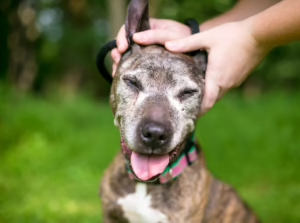For dogs, rising temperatures pose serious health risks, especially when heat builds faster than their bodies can cool. Heat stroke can happen quickly and often without much warning. However, when you know what to watch for and how to respond, you can act fast and protect your dog from long-term harm.
What Is Heat Stroke in Dogs?
Heat stroke is a severe form of hyperthermia, where a dog’s body temperature rises to dangerous levels. Unlike humans, dogs and cats have a limited ability to sweat, making it challenging for them to dissipate heat efficiently. Heat stroke happens when the body overheats and can’t cool itself down.
A normal temperature for dogs ranges from 100.5°F to 102.5°F. When their temperature climbs above 103°F, it’s considered abnormal. At 106°F or higher, heat stroke begins and at 107°F to 109°F, the risk of organ failure and death increases. Without immediate care, heat stroke can result in irreversible damage to the brain, liver, kidneys, and heart.
Causes and Risk Factors
Heat stroke doesn’t always happen under extreme conditions. It can occur in everyday situations, especially when dogs are left without ventilation or access to water. Common causes and risk factors include:
- High ambient temperature and humidity
- Poor ventilation, such as being confined in a car or small room
- Brachycephalic breeds like Pugs and Bulldogs, which have short snouts and difficulty panting efficiently
- Age and health concerns, including obesity or heart disease, that affect the body’s ability to regulate heat
Spotting the Symptoms
Recognizing early symptoms is one of the most effective ways to prevent serious complications. Many signs appear quickly and knowing what to look for can save a life. Here are key indicators to watch for:
- Behavior Changes: The first signs of heat stroke are often behavioral. A dog may pace or appear anxious, while a cat may seem unsettled or hide.
- Excessive Panting and Drooling: While panting is normal for dogs, excessive panting, particularly when accompanied by drooling, can signal that your dog is struggling to cool down.
- Rapid Heart Rate: An unusually fast heart rate, even when your dog is resting, is a red flag that warrants attention.
- Vomiting or Diarrhea: Gastrointestinal distress, especially when paired with other symptoms, can indicate heat stroke.
- Bright Red or Pale Gums: Changes in gum color can be an immediate visual cue of distress. This color change signals poor oxygen flow and increasing internal strain.
- Dizziness or Staggering: A lack of coordination, stumbling or even collapse can suggest that your dog’s body is overwhelmed by stress of the heat.
First Steps to Take at Home
If you suspect your dog is suffering from heat stroke, immediate action can help mitigate the effects.
Start by moving your dog out of the heat. A shaded or air-conditioned space is ideal. Apply cool — not cold — water to their body, focusing on directly wetting the belly, inner legs, and paws. Use fans or open windows to help with evaporative cooling.
Make sure to avoid ice, freezing water, or placing wet towels on your pet. Because when blood vessels constrict (become smaller), heat becomes trapped in the body and decreases the efficiency of cooling.
When to Seek Emergency Care
While early intervention at home is crucial, there are times when professional help is necessary. Emergency care ensures that your dog receives vital treatments such as intravenous fluids, oxygen therapy, and other supportive treatments necessary for recovery. It’s time to seek emergency veterinary care if:
- Your dog is unresponsive or has lost consciousness.
- Their symptoms persist despite initial cooling efforts.
- They exhibit severe vomiting or diarrhea.
- Their breathing becomes labored or shallow.
While transporting your dog, keep them cool. Continue using water and airflow. Once their temperature drops to 103°F, stop active cooling to prevent hypothermia.
Monitoring at Home
After treatment, your dog may need quiet rest and close observation. Watch for signs of fatigue, heavy breathing, or dehydration. Offer water and monitor their food intake.
If symptoms return — even mildly — contact your veterinarian again. A second episode of heat stress can be more severe.
Prevention Tips for Dog Owners
Prevention is the most effective way to protect your dog from heat stroke. Small changes in routine can keep your dog safe during warmer months:
- Always provide plenty of shade and clean water
- Skip midday walks when heat and humidity are at their peak
- Never leave your dog in a parked car, even with cracked windows
- Consider using mobile veterinary care for wellness checks or treatments at home, especially for dogs that struggle with travel or stress
A Thoughtful Reminder
While the heat of summer can be alluring, it’s essential to temper that enthusiasm with a commitment to your dog’s well-being. Being aware of the signs of heat stroke and acting swiftly can save your dog’s life.
So from all of us at ReadiVet, have a safe, happy and healthy summer!




